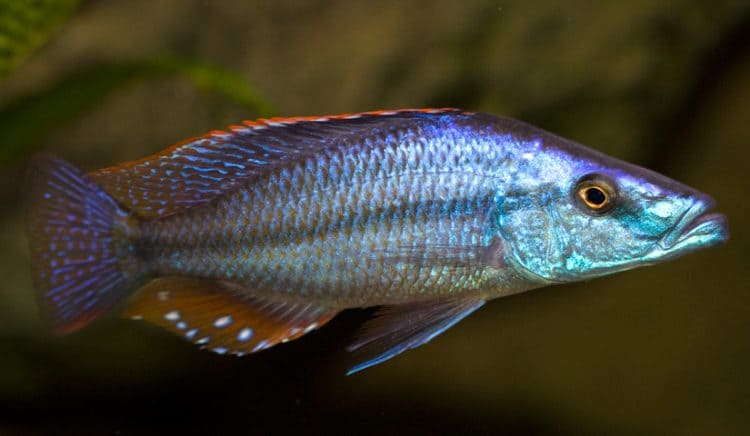
Dimidiochromis compressiceps has been on my list for many years, as a fish that I had wanted to keep and breed. I have observed this fish in the wild in its golden form at Chizumulu Island, Malawi and Cobwe, Mozambique. This golden form (male, female are both golden), is available to us Cichlid addicts, but the fish does not seem to keep the colour very well under aquarium conditions. This golden variety will turn the same blue colour as the other when it matures (males).
The males are a beautiful iridescent blue with some red flecking in the dorsal fin tips and a red anal fin. The females are plain silver. The height of the fish is fairly decent (2˝ -3 inches) but it is an elongated fish that is vertically compressed (as per the fish’s name). Males and females have a stripe down the side of the body which disappears in the male when he matures. Both have a dark stripe starting on the snout which runs the length of the back. This is a camouflaging stripe that helps hide the fish in Vallisneria beds. This fish hunts for small fish in a “heads down” position among these plants. (personal observation at Chiofu, Malawi).
Well, finally one day I was preparing for a shipment of Malawi Cichlids at work and there was a trio of D. compressiceps left in the tank. Rather than just move them, I bought them and took them home.
Once home the females were placed together in one tank and the male in another by themselves for about 2 weeks. After this quarantine period they were moved to one of my 135 gallon tanks with other breeding groups. This tank was fed heavily and then the new trio was slipped in and the lights were shut off. The trio was not very “rowdy”, but were aggressive feeders. Within a month one of the females had spawned and soon after, the other one as well. The date of spawning was marked on the tank with a GPX paint marker. This helps in correctly knowing when the females are due. (21 days post spawns). While the females were holding I did not see any aggression from the male and there were no torn fins.
On day 21 I removed the first female and emptied her mouth of fry into a bucket. I was surprised to see that the fry were not as big as some of the other “Hap” species that I had spawned, but not so surprised with the amount of fry, which numbered around 40-50. The fry were placed into a 2˝ gallon tank for the next month and fed baby brine shrimp. Growth was good and they were soon moved to a 25 gallon tank.
Leave a Reply